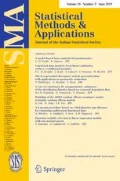Abstract
Propensity score methods are an increasingly popular technique for causal inference. To estimate propensity scores, we must model the distribution of the treatment indicator given a vector of covariates. Much work has been done in the case where the covariates are fully observed. Unfortunately, many large scale and complex surveys, such as longitudinal surveys, suffer from missing covariate values. In this paper, we compare three different approaches and their underlying assumptions of handling missing background data in the estimation and use of propensity scores: a complete-case analysis, a pattern-mixture model based approach developed by Rosenbaum and Rubin (J Am Stat Assoc79:516–524, 1984), and a multiple imputation approach. We apply these methods to assess the impact of childbearing events on individuals’ wellbeing in Indonesia, using a sample of women from the Indonesia Family Life Survey.
Similar content being viewed by others
References
Becker S, Ichino A (2002) Estimation of average treatment effects based on propensity scores. STATA J 2(4): 358–377
Frangakis CE, Rubin DB (1999) Addressing complications of intention-to-treat analysis in the combined presence of all-or-none treatment-noncompliance and subsequent missing outcomes. Biometrika 86: 365–380
Gu XS, Rosenbaum PR (1993) Comparison of multivariable matching methods; structures, distances, and algorithms. J Comp Graph Stat 2: 405–420
Heckman JJ, Ichomura H, Todd PE (1998) Matching as an econometric evaluation estimator. Rev Econ Stud 65: 261–294
Hill J (2004) Reducing bias in treatment effect estimation in observational studies suffering from missing data. Working paper series, School of International and Public Affairs, Columbia University, New York
Klepinger D, Lundberg S, Plotnick R (1995) Instrumental selection: the case of teenage childbearing and women’s educational attainment. DP 1077-95, 1995 29 pp
Little RJA, Rubin DB (1987) Statistical analysis with missing data (2nd edition in 2002). Wiley, New York
Royston P (2004) Multiple imputation of missing values. Stata J 4: 227–241
Rosenbaum PT, Rubin DB (1983) The central role of propensity score in observational studies for causal effects. Biometrika 70(1): 41–55
Rosenbaum PT, Rubin DB (1984) Reducing bias in observational studies using subclassification on the propensity score. J Am Stat Assoc 79: 516–524
Rubin DB (1976) Inference and missing data. Biometrika 63: 581–592
Rubin DB (1978) Multiple imputation in sample survey: a phenomenological Bayesian approach to nonresponse. In: The Proceedings of survey research methods section of the American Statistical Association, pp 20–34
Rubin DB (1987) Multiple imputation for nonresponse in surveys. Wiley, New York
Rubin DB (1996) Multiple imputation after 18+ years (with discussion). J Am Stat Assoc 91: 473–489
Rubin DB, Thomas N (1992a) Affinely invariant matching methods with ellipsoidal distribution. Ann Stat 20: 1079–1093
Rubin DB, Thomas N (1992b) Characterizing the effect of matching using linear propensity score methods with normal distributions. Biomatrika 79: 797–809
Rubin DB, Thomas N (1996) Matching using estimated propensity score; relating theory to practice. Biomatrics 52: 249–264
van Buuren S, Boshuizen HC, Knook DL (1999) Multiple imputation of missing blood pressure covariates in survival analysis. Stat Med 18: 681–694
Author information
Authors and Affiliations
Corresponding author
Additional information
I am grateful to all the participants at the project “Poverty Dynamics and Fertility in Developing Countries” for their support and encouragement. Special thanks are due to Fabrizia Mealli for her insightful suggestions and discussions. I also thank Jungho Kim, who is the main author of the STATA code to produce Indonesia consumption expenditure. Finally, I thank Arnstein Aassve, and Letizia Mencarini for help working with the data and their very useful discussions, and Alexia Fuernkranz-Prskawetz, and Henriette Engelhardt for detailed comments and suggestions which have improved the paper. Financial support from CNR-EFS and COFIN 2005 is gratefully acknowledged.
Rights and permissions
About this article
Cite this article
Mattei, A. Estimating and using propensity score in presence of missing background data: an application to assess the impact of childbearing on wellbeing. Stat Methods Appl 18, 257–273 (2009). https://doi.org/10.1007/s10260-007-0086-0
Accepted:
Published:
Issue Date:
DOI: https://doi.org/10.1007/s10260-007-0086-0




